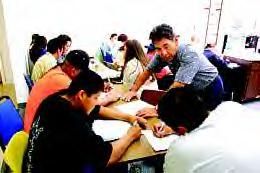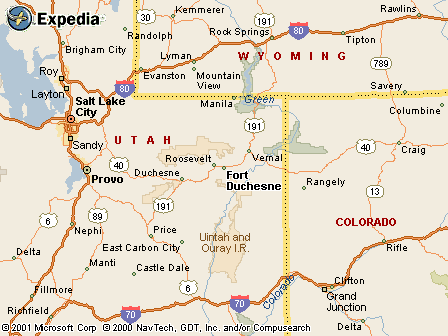|
|
Canku Ota |
|
|
(Many Paths) |
||
|
An Online Newsletter Celebrating Native America |
||
|
September 8, 2001 - Issue 44 |
||
|
|
||
|
Students Aiming High |
||
|
by Twila Van Leer Deseret News staff writer-September 3, 2001 |
||
|
Photo by Tom Smart, Deseret News |
 FORT DUCHESNE
— "Honoring the Past, Preparing for the Future." FORT DUCHESNE
— "Honoring the Past, Preparing for the Future."That written objective for Uintah River High School includes pushing post-high school education for many of its students, a departure from years in which few of the Uinta Basin's Ute Indian children looked at higher education as a desirable option. School has barely begun for the 2001-02 year, but already some students have their sights set on futures that include more study. "Anthropology or medicine," said Ashley Groves. And she knows which university might offer the better opportunity, depending on her ultimate choice. "Brigham Young University has better courses in anthropology, but if I decide on medicine, it will be the University of Utah." She knows, too, that the U. School of Medicine accepts just one in four applicants. "I'll have to be good." There are less ambitious goals among the class of 2002 as well. Nina Mills is looking at the military, another route to more education, and Sunshine Pike will go into a shorter-term cosmetology program. The aim is the same — to prepare for a job that could provide economic security as these young people move into adult life. The alternative is to perpetuate conditions that include high unemployment, problems with drug and alcohol abuse, a high suicide rate and many social problems on the reservation, said Kathy Cochrane, Uintah River principal. Just seeing students set objectives while still in high school is an encouraging sign for Cochrane. That focus on preparation for higher education was almost serendipitous, she said. "Last year, we didn't concentrate on preparing students for higher education per se." But the school's enriched program, which includes Ute culture and language with other state-required curricula, had the natural effect of turning students toward higher aspirations, she said. The majority of last spring's graduates are now either in a higher education program or planning to be, she said. "It was a total shock. We're going to work harder on it." The Ute Tribe is working on several economic opportunities that could provide employment for students with post-high school training, she said. "Education is their way out of poverty." The school plans field trips to institutions of higher education, including an outing to Utah State University, to expose students to post-high school opportunities. And Cochrane has personally taken students to the USU outreach programs in the basin or to the local Applied Technology Center (which recently became a college) to get them enrolled in concurrent classes. "It was a personal thing. I helped them to register and take care of the preliminaries. Then I stayed the whole day the first day, maybe 10 minutes the second day — kind of weaned them until they were on their own." The reservation school, which has a student body that is about 80 percent American Indian, asked for and received charter status in Utah's school system so it could have the flexibility to pursue several objectives, said Cameron Cuch, education director for the Ute Tribe. Historically, Ute students have attended public schools in Duchesne and Uintah counties, he said. They have had an 80 percent dropout rate, although the districts have made attempts to be sensitive to cultural issues. Uintah River, funded from federal, state and tribal sources, "is trying not to perpetuate what public education has done," Cuch said. "We're charting our own course. We needed the flexibility to do what we feel is important." That includes a longer day — from 8 a.m. to 4:30 p.m. — and longer two-hour class periods. Courses are broken into 18-day blocks, so students "get a quicker pay-off," Cochrane said, rather than waiting the usual semester term for report cards. "If they see success in little increments, they're more likely to repeat." Parents are required to become involved, she said. If a parent misses three consecutive monthly meetings, the student is dropped from Uintah River rolls. And the school is becoming more selective, refusing to take transfers from the local high schools where attendance problems or behavior are the motivation. "If it's a question of academics, we can work it out," she said. This fall, the school began its third year. Two of its four teachers are Indians. A language coordinator has been hired to encourage students to learn Ute, a Uto-Aztecan Shoshonean tongue that is being lost to the younger generations, he said. The language has no written form, other than a phonetic translation, and there "is a sense of urgency to preserve it," Cuch said. Ute language, history and culture are integrated into the curriculum. Students are taught to value American Indian contributions to the world, including agriculture ("50 percent of what we eat was first grown by Native Americans,") architecture, art and in other fields. "It's important for our students to know these things," said Cuch, whose father, Forrest S. Cuch, heads the Division of Native American Affairs in Gov. Mike Leavitt's government. The younger Cuch welcomes the overtures that are being made by some of Utah's institutions of higher education, especially USU, to encourage Indian participation and to help ease the way for students. He received his own advanced schooling at the University of Massachusetts, where the family lived for some time, and "recognized how fortunate I had been. I wanted to give something back." That desire to return something to their Indian groups is often the motivation for students looking at higher education, he said. Opportunities to apply higher education skills at home have never been better, with many tribes developing casinos and other businesses, particularly those that cater to the tourist trade. |
|
|
|
Northern Ute Tribe |
|
|
||
|
|
||
| Canku Ota is a free Newsletter celebrating Native America, its traditions and accomplishments . We do not provide subscriber or visitor names to anyone. Some articles presented in Canku Ota may contain copyright material. We have received appropriate permissions for republishing any articles. Material appearing here is distributed without profit or monetary gain to those who have expressed an interest. This is in accordance with Title 17 U.S.C. section 107. | ||
|
Canku Ota is a copyright © 2000, 2001 of Vicki Lockard and Paul Barry. |
||
|
|
|
|
|
The "Canku Ota - A Newsletter Celebrating Native America" web site and its design is the |
||
|
Copyright © 1999, 2000, 2001 of Paul C. Barry. |
||
|
All Rights Reserved. |
||

